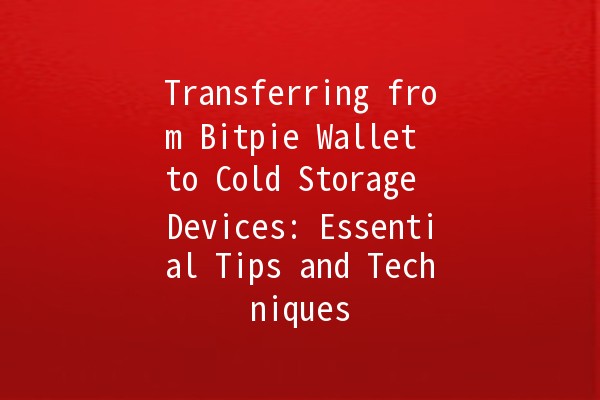




In the everevolving landscape of cryptocurrency, ensuring the safety and security of your digital assets is paramount. Many crypto users, whether seasoned investors or newcomers, often find themselves exploring how to safely transfer funds from a hot wallet, such as Bitpie, to cold storage devices. The transition from a digital wallet that is connected to the internet to offline storage is crucial to mitigate risks like hacking, theft, or loss due to software failures. This article provides actionable insights, productivityenhancing techniques, and practical steps to successfully navigate this process.
Before delving into the transfer process, it's essential to understand what hot wallets and cold storage mean.
Hot wallets, like Bitpie, are digital wallets that are connected to the internet. They are userfriendly, allowing you to easily send and receive cryptocurrencies. However, their online nature makes them more vulnerable to cyber threats.

Cold storage, on the other hand, refers to keeping cryptocurrencies offline. This method is typically much safer as it is less susceptible to online hacks. Popular cold storage options include hardware wallets (like Ledger and Trezor), paper wallets, and secure USB drives.
Successfully transferring assets from Bitpie to a cold storage device involves careful planning. Here are some key factors to consider:
Ensure you clearly understand your reasons for transferring assets to cold storage. Is it for longterm holding, or to increase security against potential threats?
Decide which type of cold storage best suits your needs. Consider factors like ease of use, security level, and potential costs.
Ensure you have robust security protocols in place during the transfer process, including using twofactor authentication (2FA) and keeping your recovery phrases secure.
Transferring funds safely can be a complex task, but employing effective techniques can enhance your productivity throughout the process.
Explanation:
Having a checklist helps eliminate the risk of forgetting critical steps during the transfer. It serves as a practical guide to follow throughout the process.
Application Example:
Draft a checklist that includes tasks like verifying wallet addresses, ensuring security measures are in place, confirming transaction fees, and documenting recovery phrases.
Explanation:
Employing reliable security tools can add an extra layer of protection while making your transfer. This includes antivirus software, secure internet connections (like VPNs), and secure messaging apps for sharing sensitive information.
Application Example:
Before starting the transfer process, ensure your computer is equipped with the latest antivirus software. Also, consider using a VPN when accessing your wallet to prevent unauthorized tracking.
Explanation:
Keeping your wallets' and devices' software up to date is essential for security. Updates often include important patches that protect against vulnerabilities.
Application Example:
Regularly check for updates on your Bitpie wallet and your cold storage wallet’s firmware to ensure you are using the most secure version available.
Explanation:
Performing a small test transaction before sending larger amounts helps ensure that the entire process works smoothly and minimizes risks.
Application Example:
Transfer a small amount of cryptocurrency from your Bitpie wallet to your cold storage to verify functionality, then proceed with the larger transfer.
Explanation:
Keeping detailed records of every transaction is vital, not just for your security but also for future references or audits.
Application Example:
Maintain a secure log or spreadsheet of all transactions, including dates, amounts, and wallet addresses, ensuring that this documentation is backed up securely.
Before initiating the transfer:
Set up your cold storage device following the manufacturer’s instructions.
Ensure that it is initialized and ready to receive funds.
Access your Bitpie wallet securely, ensuring you’re on a safe network.
If enabled, complete any twofactor authentication required to access your account.
Choose the cryptocurrency you intend to transfer.
Go to your cold storage device and locate the wallet address for receiving funds. Copy it carefully, doublechecking for errors.
Back in your Bitpie wallet, select the “Send” option, enter the recipient address (from your cold storage), and input the amount.
Carefully review all details, including fees, before confirming the transaction.
Use a blockchain explorer to confirm that the transaction is completed.
Safely check your cold storage device to ensure the funds have arrived.
Immediately document the transaction details and any necessary followup actions.
A1: The main advantage of cold storage is enhanced security. By keeping your assets offline, you significantly reduce the risk of being hacked or experiencing theft associated with online wallets.
A2: The frequency of transferring assets to cold storage depends on individual security preferences and investment strategies. As a general rule, if you plan to hold cryptocurrency for the long term, consider making regular transfers to cold storage, especially after market volatility events.
A3: Yes, many cold storage devices support multiple cryptocurrencies, allowing you to transfer various assets as needed. However, verify that your cold storage device is compatible with the cryptocurrencies you intend to transfer.
A4: Unfortunately, cryptocurrency transactions are irreversible. If you send funds to the wrong address, they cannot be recovered. To avoid this, always doublecheck wallet addresses before confirming transactions.
A5: Yes, there may be transaction fees associated with transferring funds, which vary based on the cryptocurrency and network conditions. Ensure you are aware of these fees before proceeding with a transaction.
A6: To keep your cold storage device secure, ensure it remains offline whenever not in use, choose a reputable brand, regularly update its firmware if applicable, and store recovery phrases in a secure location, away from prying eyes.
Transferring cryptocurrency from a Bitpie wallet to cold storage devices is a fundamental practice for safeguarding your digital assets. By implementing the mentioned productivity techniques and understanding the intricate steps of the transfer process, you can enhance your security and peace of mind in the volatile world of cryptocurrencies. Always prioritize safety and remain vigilant against potential threats to ensure your investments stay protected.